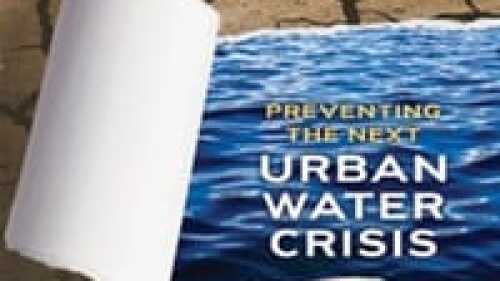Urban Planning Tools for Climate Change Mitigation
Patrick M. Condon, Duncan Cavens, and Nicole Miller
Lincoln Institute of Land Policy
113 Brattle Street, Cambridge, MA 02138;
www.lincolninst.edu .
2009. 48 pages. $15.00, paperback.
Planning for Climate Change in the West
Rebecca Carter and Susan Culp
Lincoln Institute of Land Policy
113 Brattle Street, Cambridge, MA 02138;
www.lincolninst.edu .
2010. 56 pages. $15.00, paperback.
How are local governments planning to regulate development to cope with climate change? These two policy focus reports from the Lincoln Institute of Land Policy provide a brisk and authoritative state-of-the-art review. They describe both leading-edge planning tools and the state of practice in the Intermountain West—the 11 states west of the Rocky Mountains where progressive state climate action plans have been enacted.
The Lincoln Institute is a Massachusetts-based private foundation whose mission is to improve the quality of debate and decisions on land policy and taxation. In partnership with the Design Centre for Sustainabilty on the tools report and the Sonoran Institute on the western study, Lincoln convened climate change workshops with experts, decision makers, and planners as background for these reports.
The authors of the reports are experts in climate change mitigation. Patrick Condon, Duncan Cavens, and Nicole Miller, the lead authors of the Urban Planning Tools for Climate Change Mitigation report, are located at the University of British Columbia’s School of Architecture and Landscape Architecture and its Design Centre for Sustainability. They are joined by a slate of contributors from top consulting firms, including Eliot Allen of Criterion Planners and John Fregonese of Fregonese Associates, both based in Portland, Oregon.
Urban Planning Tools assesses the ability of leading decision support tools to model alternative urban development approaches, ranging from project to neighborhood to metropolitan scale. Tools are evaluated according to their ability to capture greenhouse gas (GHG) contributions from buildings, land use, transportation, and other relevant sectors. The evaluation seeks to answer the question of which urban forms do the best job of reducing GHGs.
assesses the ability of leading decision support tools to model alternative urban development approaches, ranging from project to neighborhood to metropolitan scale. Tools are evaluated according to their ability to capture greenhouse gas (GHG) contributions from buildings, land use, transportation, and other relevant sectors. The evaluation seeks to answer the question of which urban forms do the best job of reducing GHGs.To ensure that the tools analyze relevant urban forms, they are applied in community charrettes to evaluate development scenarios developed by local stakeholders. Proposed urban forms are graphically displayed and their GHG emission reductions compared. This collaborative planning process enables large groups of participants to openly test different arrangements of structures, land use, and transportation investments during public workshops, overcoming the traditional disconnect between citizens and technical analysts and producing more informed development decisions. This process offers developers, environmentalists, and other interests an excellent opportunity to influence community goals and visions.
The Tools report compares 12 tools. It also presents case studies of selected U.S. and Canadian applications of four tools: INDEX, I-PLACE3S, Envision Tomorrow, and Development Pattern Approach. In each case, the sustainability implications of future development patterns are identified.
Rebecca Carter and Susan Culp, authors of Planning for Climate Change in the West, have worked with the Sonoran Institute, a Tucson, Arizona–based nonprofit whose mission is to inspire policies that respect western land and people. Climate change forecasts for the West anticipate drought, heat waves, diminished mountain snowpack, earlier snowmelt, catastrophic wildfires, and disruptions to natural processes and wildlife habitat. The authors focus on the local response to state-produced climate action plans from the ten western states with completed climate action plans as of 2009.
Of the 30 to 60 quantified policy options for reducing GHG emissions typically found in state plans, about a dozen relate to local government action on land use and transportation planning. To implement state plans, local government actions are imperative. However, western localities face challenges ranging from accommodating high growth in urban and natural amenity areas to coping with declining populations and tax bases in rural areas. Concern about and political support for climate change action varies from robust to reluctance to acknowledge the issue.
Fortunately, the same measures that promote sustainability, energy efficiency, and economic growth also serve to mitigate climate change. Familiar smart growth strategies for creating healthier communities —building codes and standards, compact mixed-use development, transportation alternatives, distributed and renewable energy, water resource conservation, open space and agriculture preservation, and mitigation of wildfire impacts—double as climate solutions.
Carter and Culp recommend that communities focus on sustainability, economic and energy efficiency, and the cobenefits of local actions rather than on politically controversial policies and goals. They encourage fostering citizen participation and buy-in, building regional peer community networks to share experiences, and adapting climate science to local planning needs.
Taken together, these two reports serve as early warnings about the likely course of mitigation of and adaption to climate change impacts in the United States. Analytical methods will be transparent, quantifiable, and tested in public forums. Implementation measures will be based on familiar smart growth strategies. Thus, while expected climate change impacts are drastic and unprecedented, we already know a lot about how to mitigate them by applying and extending our current arsenal of analytical and growth management tools.




